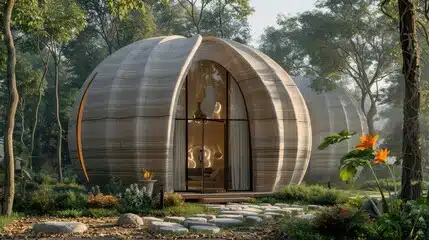3D printed houses for sale — right here in Ohio? You read that right! Innovative new technology powering mass production of 3D-printed houses is moving them toward the mainstream across the United States.
So far, 3D homes have shown tons of benefits that include faster, more cost-effective production as well as greater longevity and an overall more eco-friendly footprint.
In this guide, we’ll take a look at where 3D home printing stands from an industry adoption standpoint, where they’re being built right now in Ohio, and what to know if you’re considering a 3D-printed home for your family.
Quick Takeaways
- Right now, 3D printed homes are mostly being used in mass-production scenarios such as low-income housing, senior living communities, and disaster relief.
- Ohio-based company Pantheon Innovative Builders is spearheading the growth of 3D home printing in the Buckeye State.
- Important considerations to think about when buying a 3D-printed home include builder expertise and experience, construction speed, building materials, and home size.
What’s the deal with 3D printed houses?
3D-printed houses have emerged in recent years as showing huge potential to save time and money related to home building while also making a positive impact on the environment.
They haven’t quite become a mainstream building method yet, but they’ve shown promise and are available in some areas in the U.S. real estate market today — including Ohio.
In most cases today, 3D-printed houses for sale are being designed for low income housing and other scenarios where mass production makes sense (senior living communities are another example). But as the technology advances and 3D homes continue to show high potential, it’s likely we’ll see them gain wider adoption and popularity with homebuyers in coming years.
Thanks to their highly automated, machine-driven construction method, 3D printed houses can be built in just a few days, which also suggests potential for use as disaster relief spaces and/or as a method for buildings that have a particular need for solid structure to withstand elements.
In the video below, you can see 3D home printing technology in action from ICON, a global leader in 3D home construction.
Where are they being built in Ohio?
Right now, you won’t find many (if any) 3D printed homes on the Ohio real estate market — but that doesn’t mean they don’t exist in the Buckeye State. Nonprofits like Habitat for Humanity have been adopting 3D printing technology more widely and will likely continue to expand their use to new projects across the United States.
Notably, an innovative new company called Pantheon Builders has recently shared plans to use 3D home building technology to rejuvenate Ohio’s Youngstown area.
“We’re looking at the challenges that are facing the construction industry. The supply chain issues, the skilled labor force issues,” said Pantheon Founder & CEO Ryan Kelly. Their solutions, he says, have the potential to help grow the larger industry.
Right now, Pantheon is mostly focusing on providing low-income housing in Youngstown but will also build for anyone wanting to commission a new construction 3D-printed home.
If you think a 3D home is something you might consider in the future, there are a few important things to look for as you search: builder expertise, speed of construction, building materials, and size potential. Let’s look more closely at each.
4 Things to Look for When Buying a 3D-Printed Home
Builder expertise
Builder expertise is critical when you’re building any new construction home, but especially in the case of 3D-printed homes, when technology is so new. Look for a builder that demonstrates true expertise in this building method and can guide you through it from start to finish.
Ideally, your builder should be able to discuss previous and current 3D-home building projects they’re working on and provide references to back it up.
Speed of construction
If fast construction is part of your reasoning for going the new construction route, talk to your builder specifically about their timeline. Just because 3D-printed homes can be built in a few days doesn’t mean they always are. Given the limited number of laborers skilled in this area and ongoing supply chain issues, the process may take longer in some cases.
As the buyer, you want to be confident in the timeline you’re given so you can plan appropriately to sell your current home, end a current lease, and/or make other important arrangements.
Building materials
Before you buy a 3D-printed home, make sure you know about the building materials being used and how they might impact your home’s longevity and quality of living. For the most part, 3D-printed homes are built to be more durable than other building methods, so it’s likely you won’t have to worry in that regard.
At the same time, however, the concrete-like materials used to build 3D-printed homes can be harder to temperature control and may not align with your aesthetic preferences.
In short: Know the materials your builder will use, how they look, how long they last, and any other important information you need to know about their upkeep and impact.
Size potential
The full size potential of 3D-printed homes is still being explored. Right now, most 3D-printed homes are fairly small and built with economic considerations top-of-mind. If you’re looking for a large home, the 3D-printed route may not yet be where it needs to be to meet your needs.
That said, family-sized homes are being built with 3D printers around the world. You should talk to your individual builder if you have questions about home size.
Moving to the Dayton area? The team at Oberer Homes can help you find a home you love. Contact us today to get started.
Share this Post
